Roti Recipe- How to make Roti/Chapati
Roti or Chapati is everyday Indian flatbread which is made with only 2 ingredients- whole wheat flour (atta) and water. Learn all the tips to make soft roti at home!
This post may contain affiliate links. Please read our disclosure policy.
Learn all the tips and tricks to make soft roti at home.
This everyday Indian flatbread was a staple growing up, one that I ate every single day.
Roti is made of whole wheat flour and nothing else really and is eaten in India with dal and curries.
Roti is an integral part of Indian cuisine, the north Indian cuisine especially.
I was born and raised in north India and grew up eating it everyday of my life.
Roti, dal and rice were always on the table in my house for literally every meal.
It took me several years to learn to how to make a good roti. Trust me, it’s a skill which needs a lot of practice.
I learnt so much cooking but this was something that took time. Now, after making years I am confident enough to make rotis and make them several times every week.
What is Roti?
In simple words, roti is a flatbread made with wholemeal wheat flour. It is known as “atta” in hindi.
Atta is also used to make other breads like paratha and puris in India on a daily basis.
Roti is simplest bread that is made everyday in Indian households. It is made with only 2 ingredients- atta (the wheat flour) and water.
Some people add salt, some add oil but in my house it was always made with these 2 ingredients only.
Like I said, it is the simplest form of bread.
It is known by different names in different parts of the country and sometimes there’s also a difference in the way you cook it.
Roti/Phulka/Chapati/Rotli are more or less the same thing.
They might have some difference in their thickness (like rotli in Gujarat is very thin while my North-Indian version is slightly thicker) and the way they are cooked but more or less they are same.
You need a rolling pin and a rolling board to make this flatbread. We call it chakla (the board) and belan (the rolling pin) in hindi.
Is roti vegan? Yes, if you don’t apply ghee on the roti after it’s cooked, then it is vegan.
My mom never applied any ghee on roti, I guess it’s just not a tradition to have ghee on roti in eastern Uttar Pradesh (where I am from).
On the other hand, Sarvesh never ate roti without ghee! He’s a punjabi and ghee is must on rotis for him.
If you want to keep it vegan, simply skip the ghee or use vegan butter.
Is roti gluten-free? The traditional roti is not gluten-free since it is made of wheat.
How is Roti Cooked
So this will vary in different parts of the country.
At my home, it was first rolled and cooked on tawa until cooked slightly and then put on direct flame until it puffs.
But at a lot of people I know (including my mother-in-law), cook it all on the tawa.
She simply uses a cloth to puff the roti directly on the tawa. Both ways are fine, it’s just what you are used to.
I usually puff it directly on flame since I like the taste better that way or maybe it’s because my tastes buds are just more used to that taste of the bread cooked on direct flame.
Tips to make soft rotis
One of the biggest challenges that I faced when I first started making rotis was that they never turned out soft.
Sometimes, they would be so hard that they could crack like a wafer. Not kidding!
Over the years and hundred of roti later, I can now make good rotis. I tried everything from adding milk to yogurt and what not but eventually realized that you don’t need any of these.
It’s a skill which comes with practice. The more you make it, the better you will get. Each step right from making the dough, kneading it, to rolling the roti is important and has an effect on the final outcome.
I am sharing you some of the things that I have learned in my roti making journey! 🙂
The dough needs to be soft and pliable– now, I know this can get confusing. But you have to knead a soft dough.
If the dough feels too tight- add more water, start by adding 1-2 teaspoons at a time and add more as needed.
If the dough feels too wet/sticky- add more flour.
It should be smooth and when you press the dough with your fingers, it should leave an impression.
Knead with warm water- not a really big deal but it definitely helps if you use warm water to knead the dough.
You can even add some oil to the dough. I don’t do it though but some swear by it.
Knead the dough with the knuckles on your fingers- stretch the dough, knead using the knuckles, then fold and knead again.
Keep doing this until your dough is smooth and pliable.
Let the dough rest for 20 to 30 minutes- now this is really important. After you knead the dough, cover it with a damp cloth or a damp paper towel and let it rest for 20 to 30 minutes.
The makes the rolling easier, the rotis so much better.
Roll each dough ball to a smooth ball, round and no cracks- to roll a good roti, start with making sure that dough that you are going to roll is round and smooth.
If you start with a nice round and smooth dough, your chances of making a good roti will increase. Once the ball is round, then press it lightly between your palms to make it little flat.
Roll evenly using a rolling pin– ah! the toughest thing to do and this definitely comes with practice.
You have to apply equal pressure while rolling the roti and once you master it, the roti will automatically move as you roll.
Move the rolling pin all the way through the rolled roti so that it rolls evenly from all sides. Comes with practice so definitely don’t worry if you can’t do it in the first go.
Tawa should be hot before you add the rolled roti– this is one mistake that I did when I started making rotis and paratha. My tawa wouldn’t be hot enough and I would add the rolled roti to it.
The roti will take more time to cook since the tawa was not hot and that would result in a hard over-cooked roti.
So, make sure sure the tawa is heated well on medium-high heat before you put the roti on it.
Dust the dry flour (atta) from the rolled roti before putting it on the hot tawa– it makes your roti less dry and more soft.
Apply ghee once done- to add to the flavor and also to keep them soft, brush them with ghee once cooked.
Why my roti didn’t puff?
The most frustrating part of this entire roti making process happens when it doesn’t puff.
Even after making it for many years, I still have rotis which won’t puff.
The biggest reason is that it wasn’t rolled evenly. If it’s rolled too thin, to the point where edges are almost tearing apart (and the center of the roti is thick), then the roti won’t puff.
Make sure that its thickness is same throughout, that’s a good roti which will puff.
It also won’t puff if the dough was too tight/hard.
Frequently Asked Questions
How to store roti? If I am sending them with my husband to work, I always put an aluminium foil first, then a paper towel and then place the roti on top.
If you just roll them in an aluminium foil or paper towel, they will become soggy.
I store them the same way in the refrigerator with two layers.
How to re-heat roti? You can microwave them, just cover them with a damp cloth and microwave for 30 seconds.
You can sprinkle some water on the roti before heating them up.
Can you freeze these? Yes, you can freeze them. Just let it come down to room temperature.
Then place a parchment paper between each roti and make a stack. Then transfer the entire stack into a freezer bag and freeze.
Which brand of atta is the best? I use Sujata Gold atta and find it the best for rotis. You can use the brand that you like.
Method
1- Take 2 cups (270 grams) atta in a large bowl. Usually a round flat plate with shallow edges called paraat is used but I just had a round mixing bowl so that’s what I used.
You can add little oil if you like here, I did not add any.
2- Start adding water, little by little.
3- As you add water, mix with your hands and bring the dough together. I needed around 3/4 cup (180 ml) +1 tablespoon (15 ml) water here. You may need more or less water depending on the kind of flour.
4- Once the dough comes together, start kneading the dough. Knead with the knuckles of your finger, applying pressure.
5- Fold the dough using your palms and knead again applying pressure with your knuckles.
6- Keep kneading until the dough feels soft and pliable. If it feels hard/tight, add little water and knead again. If it feels too sticky/soft, add some dry flour and mix.
7- Once done, the dough should be smooth. Press the dough with your fingers, it should leave an impression.
8- Cover the dough with a damp cloth or paper towel for 20 to 30 minutes.
I placed my paper towel under tap water and then squeezed all the water from it and used that damp paper towel to cover the cloth.
9- After the dough has rested, give it a quick knead again.
10- Divide the dough into 12 equal parts, each weighing around 35 to 37 grams.
11- Start working with one ball, while keep the remaining dough balls covered with a damp cloth so that they don’t dry out. Take one of the balls and press it between your fingers to make it smooth.
Then roll it between your palms to make it round and smooth. There should be no cracks.
12- Press the round dough ball and flatten it slightly.
13- Now take around 1/4 cup atta in a plate for dusting the roti while rolling it. Dip the prepared dough ball into the dry flour and dust it from all sides.
14- Then start rolling the roti, using a rolling board and rolling pin.
15- Move the rolling pin lengthwise across the dough applying gentle pressure as you roll. If you are rolling it correctly, the dough will move in circular motion on its own and the roti will roll evenly. This comes with practice.
You can also roll and then take the dough and move it a little with your hands and roll again.
You will have to dip the roti in dry flour several time while rolling the roti. Anytime the dough starts sticking to the rolling pin, dip the roti into the atta from both sides and then continue rolling.
16- Roll it thin until you have a 5 to 6 inch diameter circular roti.
17- Heat the tawa (skillet) on medium-high heat. Make sure the tawa is hot enough before you place the roti on the tawa.
Dust excess flour off the rolled roti and place it on the hot tawa.
18- Let it cook for 15-30 seconds until you see some bubbles on top side. At this point flip the roti, you don’t want the first side to cook too much.
19- Now, let the other side cook more than the first side around 30 seconds more. Use a tong to see how much it has cooked from the second side now. If you see brown spots all over, means it has cooked enough.
20- Now, remove the roti from the tawa using a tong and place it directly on flame with the first side (which was little less cooked) directly on the flame.
The roti if rolled evenly will puff up, flip with a tong to cook the other side as well. The roti is done when it has brown spots, don’t burn it.
Apply ghee on the rotis immediately. Make all the roti/phulka similarly.
What if you have an induction top and can’t puff the roti on flame.
No worries, here’s how you can make chapati (or roti whatever you call it) on tawa without putting it directly on flame to puff.
21- Roll the roti as usual and place it on the hot tawa.
22- Let it cook for 30 seconds until you see some bubbles on top. At this point flip the roti. You don’t want the first side to cook a lot.
23- Now, let the other cook side until it has nice brown spots (so it should cook more than the first side).
24- Now flip again (with the first side now at the bottom), press the roti with a paper cloth, any cotton cloth or spatula. It will puff up.
Flip again to cook the other side some more. Remove from tawa and brush with ghee.
The rotis are best enjoyed warm! Serve then with dal like dal tadka and simple Indian stir-fry like bhindi masala or aloo palak.
If you’ve tried this Roti Recipe then don’t forget to rate the recipe! You can also follow me on Facebook and Instagram to see what’s latest in my kitchen!
Roti Recipe - How to Make Roti/Chapati
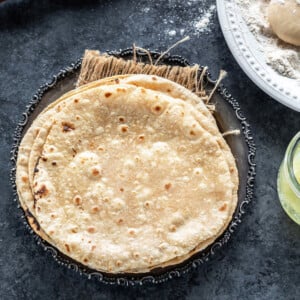
Ingredients
- 2 cups atta whole wheat flour, 270 grams + 1/4 cup for rolling the roti
- 1-2 teaspoons oil optional, 5-10 ml
- water as needed to knead a soft dough, I used around 3/4 cup (180 ml) + 1 tablespoon (15 ml)
- ghee to brush the rotis
Instructions
Knead the dough
- Take 2 cups (270 grams) atta in a large bowl. Usually a round flat plate with shallow edges called paraat is used but I just had a round mixing bowl so that's what I used.You can add little oil if you like here, I did not add any.
- Start adding water, little by little. As you add water, mix with your hands and bring the dough together. I needed around 3/4 cup (180 ml) +1 tablespoon (15 ml) water here. You may need more or less water depending on the kind of flour.
- Once the dough comes together, start kneading the dough. Knead with the knuckles of your finger, applying pressure.
- Fold the dough using your palms and knead again applying pressure with your knuckles.Keep kneading until the dough feels soft and pliable. If it feels hard/tight, add little water and knead again. If it feels too sticky/soft, add some dry flour and mix.
- Once done, the dough should be smooth. Press the dough with your fingers, it should leave an impression.
- Cover the dough with a damp cloth or paper towel for 20 to 30 minutes.I placed my paper towel under tap water and then squeezed all the water from it and used that damp paper towel to cover the cloth.
Roll the roti
- After the dough has rested, give it a quick knead again.Divide the dough into 12 equal parts, each weighing around 35 to 37 grams.
- Start working with one ball, while keep the remaining dough balls covered with a damp cloth so that they don't dry out.
- Take one of the balls and press it between your fingers to make it smooth. Then roll it between your palms to make it round and smooth. There should be no cracks. Press the round dough ball and flatten it slightly.
- Now take around 1/4 cup atta in a plate for dusting the roti while rolling it. Dip the prepared dough ball into the dry flour and dust it from all sides.
- Then start rolling the roti, using a rolling board and rolling pin.Move the rolling pin lengthwise across the dough applying gentle pressure as you roll. If you are rolling it correctly, the dough will move in circular motion on its own and the roti will roll evenly. This comes with practice.
- You can also roll a little and then take the roti and move it a little with your hands and roll again. Roll it thin until you have a 5 to 6 inch diameter circular roti.You will have to dip the roti in dry flour several time while rolling the roti. Anytime the dough starts sticking to the rolling pin, dip the roti into the atta from both sides and then continue rolling.
Cook the roti
- Heat the tawa (skillet) on medium-high heat. Make sure the tawa is hot enough before you place the roti on the tawa.Dust excess flour off the rolled roti and place it on the hot tawa.
- Let it cook for 15-30 seconds until you see some bubbles on top side. At this point flip the roti, you don't want the first side to cook too much.Now, let the other side cook more than the first side, around 30 seconds more. Use a tong to see how much it has cooked from the second side now. If you see brown spots all over, means it has cooked enough.
- Now, remove the roti from the tawa using a tong and place it directly on flame with the first side (which was little less cooked) directly on the flame.The roti if rolled evenly will puff up, flip with a tong to cook the other side as well. The roti is done when it has brown spots, don't burn it.
- Apply ghee on the rotis immediately. Make all the roti/phulka similarly. Serve warm.
Making Roti/Chapati on Induction top (without puffing on flame)
- here's how you can make chapati (or roti whatever you call it) on tawa without putting it directly on flame to puff.Roll the roti as usual and place it on the hot tawa. Let it cook for 30 seconds until you see some bubbles on top. At this point flip the roti. You don't want the first side to cook a lot.
- Now, let the other side cook until it has nice brown spots (so it should cook more than the first side). Now flip again (with the first side now at the bottom), press the roti with a paper cloth, any cotton cloth or spatula. It will puff up.
Flip again to cook the other side some more. Remove from tawa and brush with ghee.
Notes
Nutrition
Nutrition information is automatically calculated, so should only be used as an approximation.
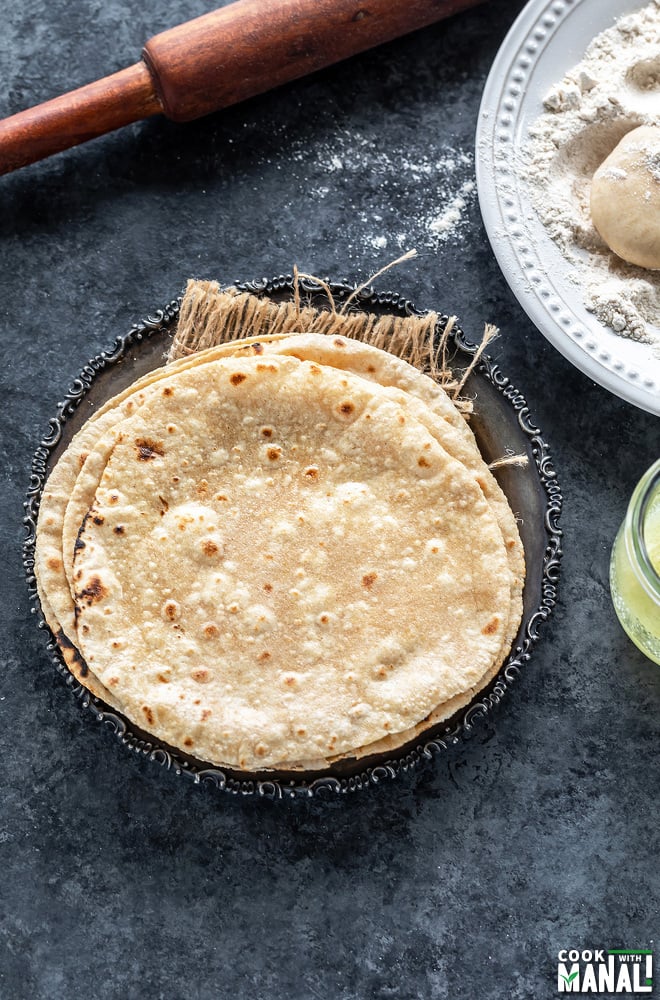
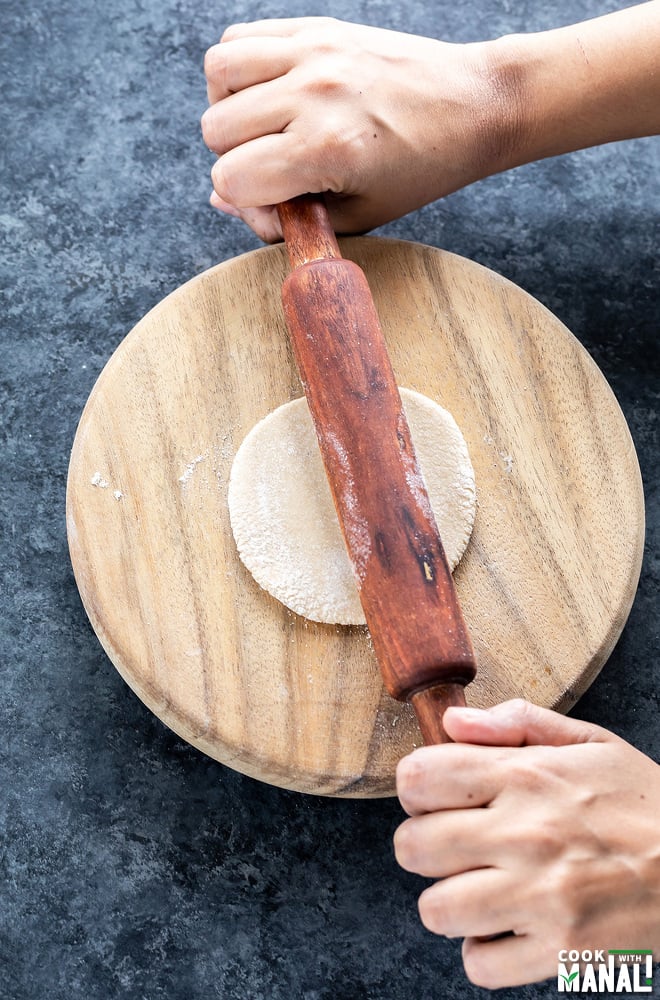
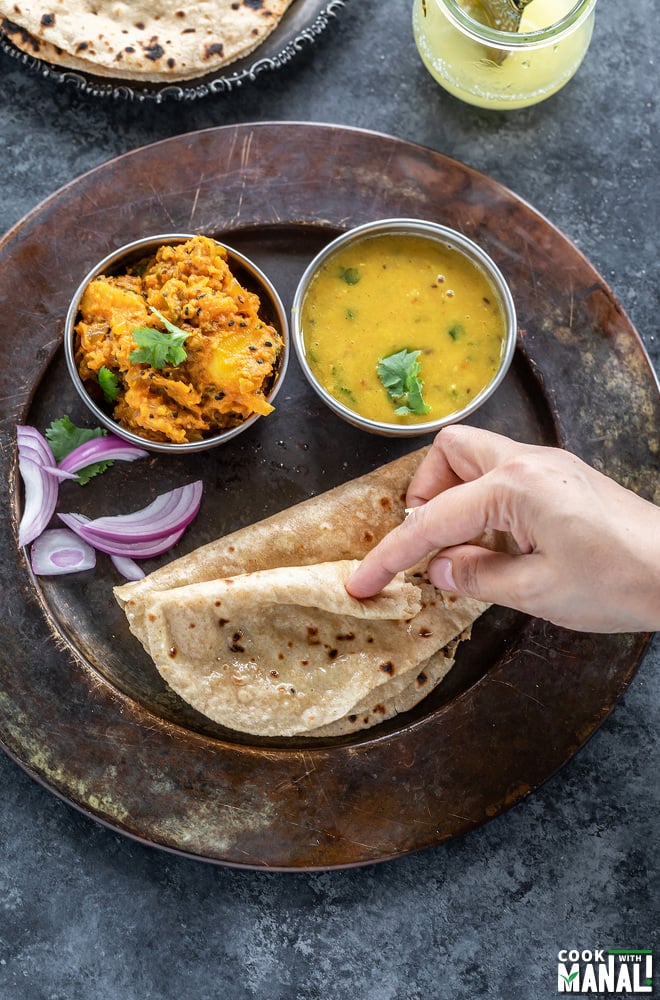
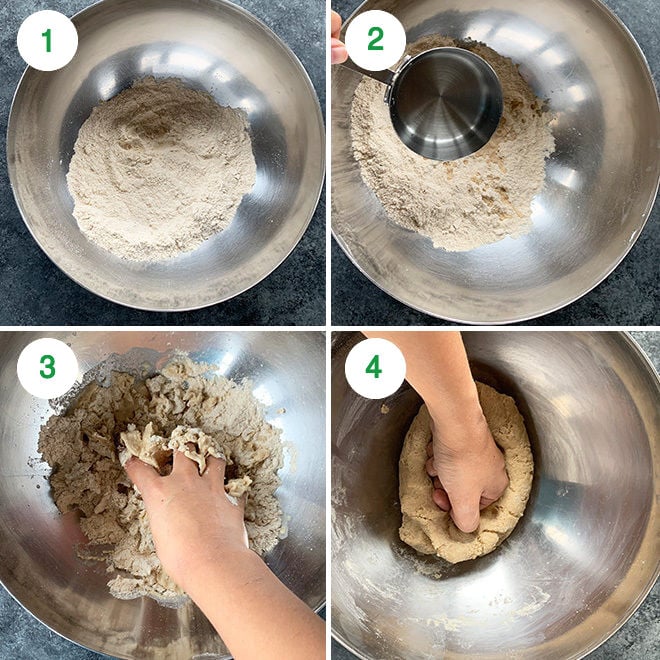
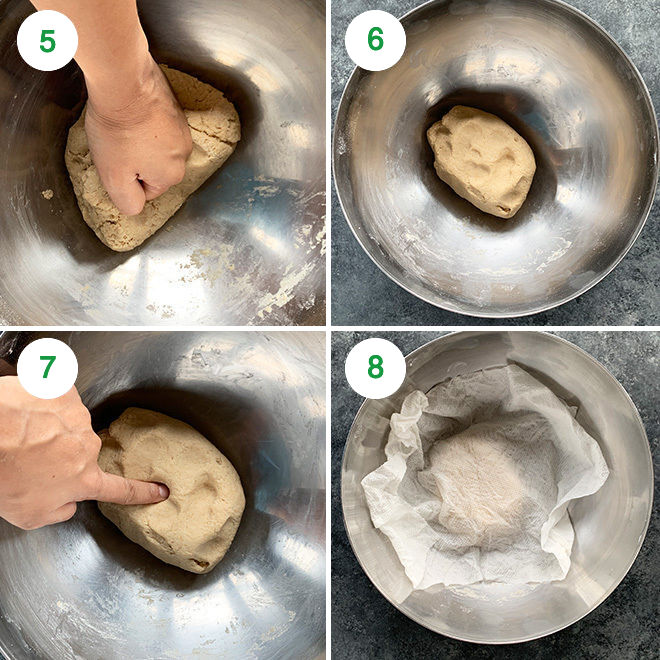
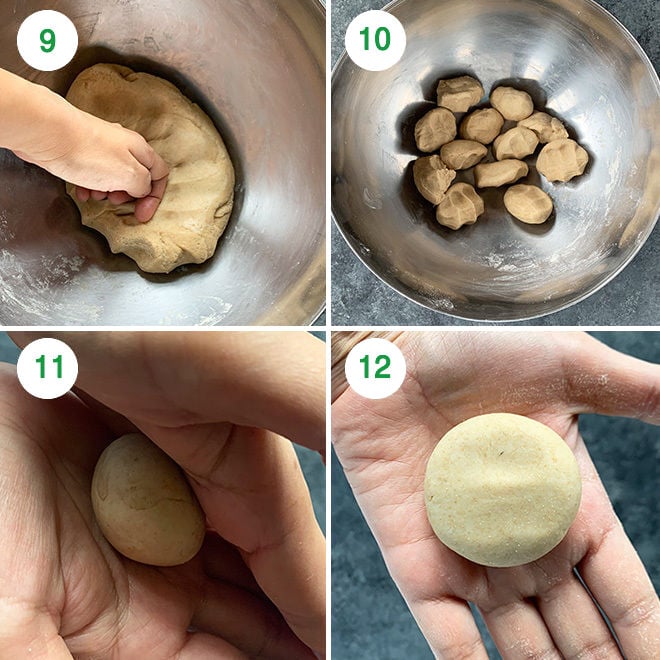
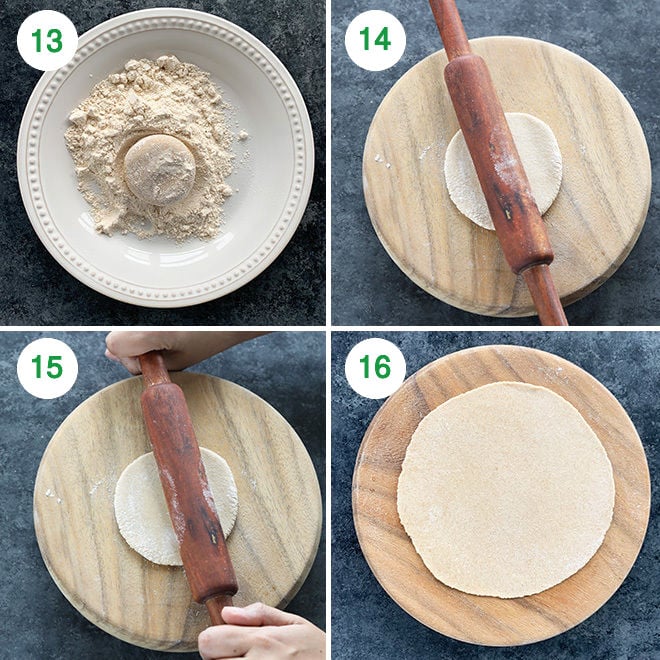
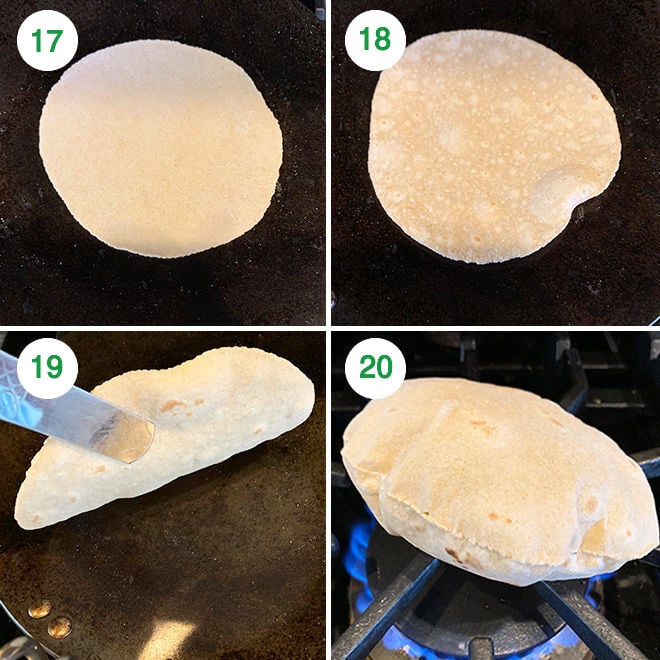
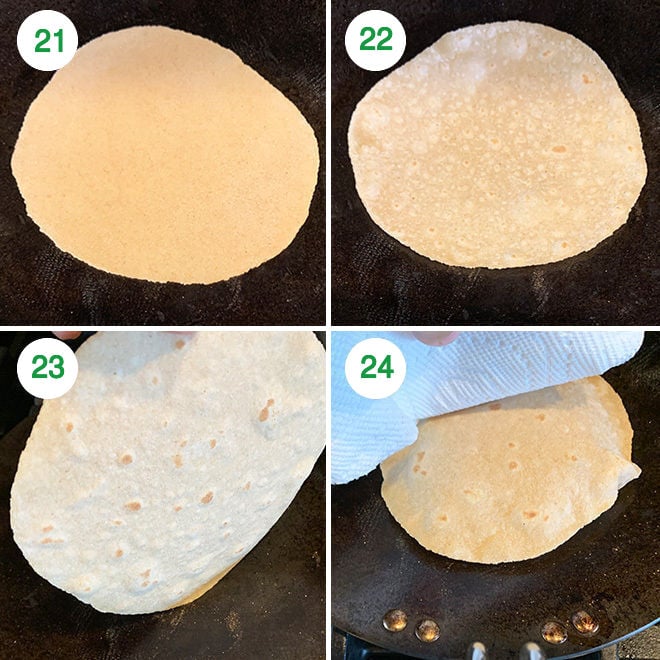
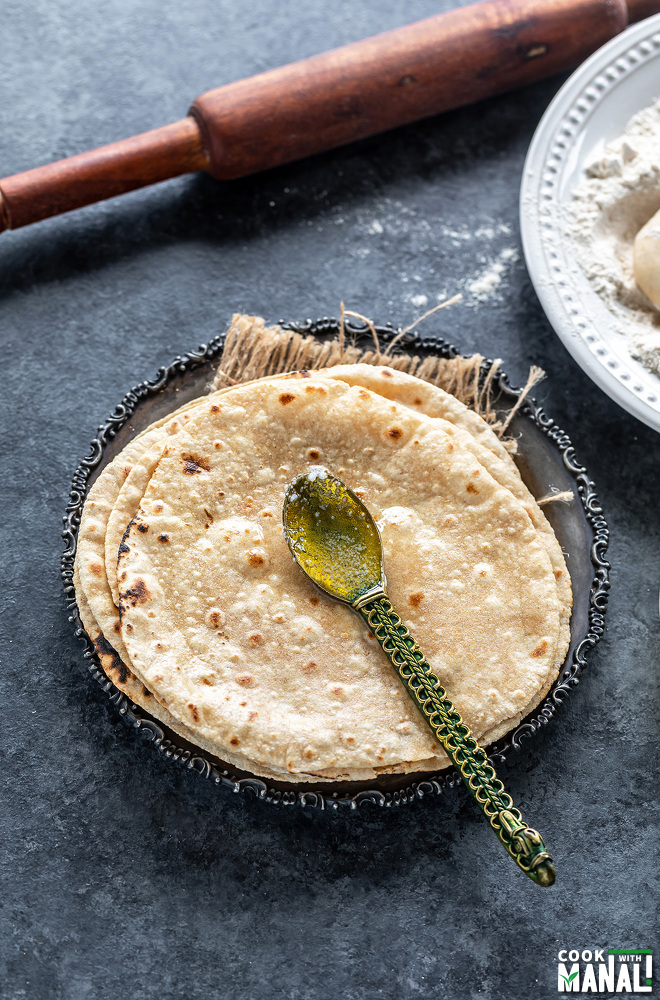

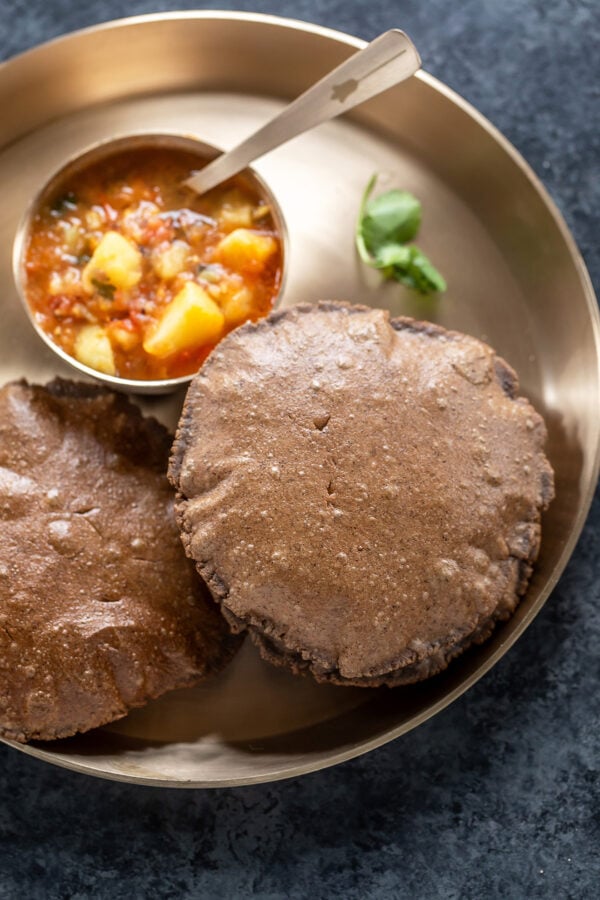
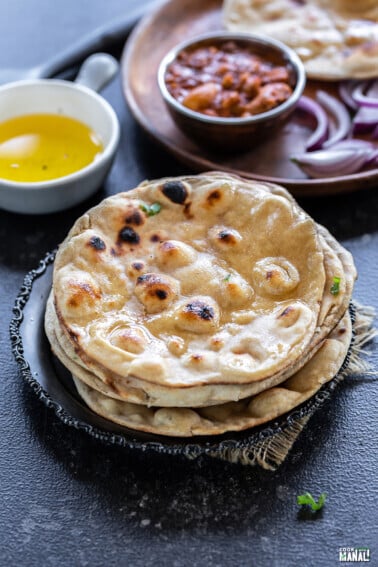
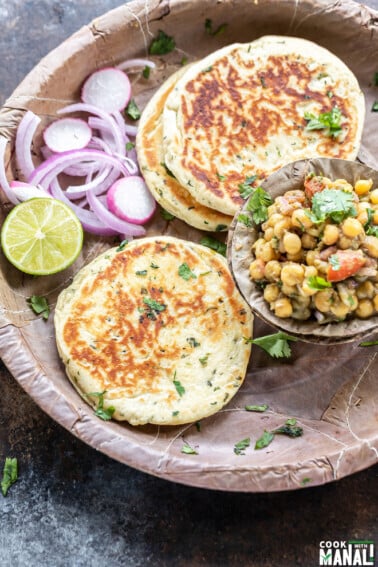
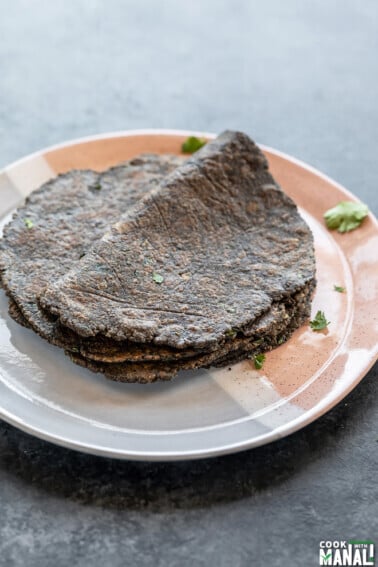









Easy and delicious! I did add a little salt to the dough but otherwise followed the recipe exactly and ate with homemade aloo gobi. Such a great meal! Will definitely be making these again 🙂 Thank you!!!
Really well-written recipe. Methods & tips were very easy to follow. This was my first attempt at making roti & it worked ? Not as good as yours look;) but am so pleased with the result! Thank you.
These wonderful Chapati turned out perfect and were super yummy with a daal
Do you cook them before freezing them? Thank you 🙂
You can try both ways and see what works best. Some people freeze just rolled roti and some cook or half cook it and then freeze. I must say I am not an expert in freezing rotis since I usually make them fresh.
Hi Manali
thanks for a great recipe. I make rotis in morning to take to office for lunch. how can i keep it soft until lunch time..? pls guide me..thanks in advance
ghee will help, also before heating, place them in paper towel and then mircowave. that will make them soft.
I just made these for the first time and they puffed up and the texture was perfect. Thank you for the detailed instructions. I followed each step and ended up with perfect delicious rotis.
awesome!
Great recipe! I love how ours turned out, except I’ll definitely add salt next time.
sure you may but salt is never added to a traditional Indian roti. It is roti not paratha 🙂
Great recipe and instructions, Manali; they were the best I found with a lot of searching. Using the atta for the dough was very pleasant and easy to work with; and most of my roti puffed on the first try. (I’ll keep working so they all do). They taste wonderful with a little ghee on them; very tender.
Works great. You need to make sure that the dough is soft so make sure it has enough water in the dough. I use a cast-iron pan to cook them. It’s similar to making corn tortillas. Other than having a corn tortilla press it’s almost exactly the same process. If you do corn tortillas correctly they also puff up. Super easy. I put the roti in a corn tortilla warmer.
Thank you so much for your detailed pictures and easy to understand descriptions! I finally made it correctly thanks to you after many not great tries using other people’s blogs.
glad to know!
Hi! I am excited to try this! How do I keep the rolled out rotis on hold while I am preparing the rest? Do I stack them?
Usually we roll the roti and cook them, one by one, there’s no stacking. But if you want to roll all and then cook after rolling, I would suggest keeping them covered with a cloth so that they don’t dry out. Keep them in a single layer.
Thank you! I made them and they were so good! They puffed up nicely on the fire, I just had to take a video!
I love your recipe and the instructions. I tried it and it turned out so nicely soft and tasty that my husband was also very complimentary of your recipe. Thanks for showing and telling the secrets of kneading and rolling rotisserie so they turn out so delicious!
Worked out perfect, thanks!
Goodmorning Manali,
Thank you!
Warmest regards,
Angel
Very well explained and just how my mum taught me. Good job.
I need nowwhat ingredients and how make it I love roti
yes everything is given, please see the recipe card and instructions
Hey thanks so much for such a detailed recipe…
I have 2 queries..
1) I used the kneader attachment of a food processor to make the dough.. Do I need to smear the sides of the kneader bowl with oil?
2) Wish I could post a pic here:-) So what is happening now is that my rotis come out soft with brown spots on both sides..I typically make the rotis on a medium flame or a little on the higher side. However there are still spots on the rotis which remain a little kaccha.. Where could I be going wrong? 🙁
1) you may but not essential
2) you are most likely not rolling the roti evenly that’s why some parts remain kacha as they are thicker. Practice rolling the rotis, it only comes with practice.
Found your site because I bought a 2.5 lb of spinach and I love Indian food. Made your aloo palak with the roti and they both turned out great! Thank you! I’ll be coming back for more recipes.
so glad to hear that! 🙂
Amazing detailed recipe, many thanks!!
I made these roti.They were the best I’ve made. I was sooo hungry I didn’t wait for the dough to rest….still delicious.
I learnt this time to really roll out the dough super thin.
Thanks
Denise
Great to know!
Hi Scott here never made roti before and if you follow your instructions correctly they come out perfect. Let be honest practice makes perfect but if your good at cooking like me and follow instructions you will get a good product. I love how people say I tried your recipe but they are too this or too that and I know it’s because they fail to follow instructions and the problem is between the floor and the bench lol. Great recipe only need to add love to succeed. Thanks Manali.
welcome Scott, glad it turned out well for you 🙂
Tks, Manali for converting the difficult art of roti making into a science! This was my first attempt and it came out really good. Stay blessed!
I looked like a pro with my round, puffy roti! My daughters gobbled them right up with a batch of yellow dal. Thank you!!
yay!
I’m thinking of making roti tomorrow night to go with Dal. We only have standard whole wheat and all-purpose flour in our house. I tried making roti with the whole wheat flour once and it came out very dense. Do you have any tips to address this?
hmm try adding oil to the dough or try adding some milk and see. We only made roti with atta in India.
loved this recipe, especially the part where you mention about the timing of turning the roti. worked like a charm. thanks a lot!
awesome!
Outstanding
Fantastic instructions, thank you. I just followed them to make chapatis for the first time ever (it took me long enough) and they were perfect! Round, super soft, paper thin, and every single one of them puffed up 100%! Honestly, watching them all puff up on the flames was so exciting and a really proud moment, haha. And I added the ghee at the end, which of course made them heavenly <3
p.s. I didn’t have a tawa, but I used a nonstick pan and that worked fine.
you definitely should be proud 🙂
These turned out so well, were a lot of fun, and much easier than I expected! I’ll be making them often from now on
awesome!
Hi! I want to make these and I was wondering if regular whole wheat flour was okay? Like Gold Medal or Kroger brand?
Making these was super fun. Watching them puff up after holding them over the flame of my stove felt like a big victory 🙂 Paired this with your Baingan Bharta recipe and your Paneer Butter Masala. A perfect, filling, satisfying dinner.
yay glad they puffed up!
Hi Manali,
Thanks for another great recipe. The details you have added help make it easier to be successful at making the rotis. I love your chole recipe. It is my go to recipe for Punjabi chole and I have looked for a good recipe for a long, long time. Thank you!!
glad to know that Pearl!
Can u use a cast iron pan if I do not own a tawa?
Thanks!
yes!
What are the two sides next to the roti in picture three? Especially the one on the right. Thanks!
Dal and Potato sabzi!
Great instructions. I didn’t even do all the steps 100% and they were still the best rotis I’ve ever made! Thanks for all these very helpful tips!!
you are welcome, glad it helped!
Eeeek thank you!!! I made my family curry the other night and decided to try my hands at roti. I used your recipe and they turned out decent for a first try, my family all loved them. Tonight I made them again and they were AMAZING! They look like your picture and they puffed right up so I’m assuming I did something right! Thank you so much for sharing your recipe and such great detailed instructions.
yay 🙂
Love the detailed steps wise explanation. Only pls say how the flame should be while making rotis. I find the rotis burning at times or too undercooked at other times. Thank you in advance.
it should be medium high heat all times.
Phantastic recipe with great instructions, made it second time – first time did it with a recipe that wasn’t good in giving details – and now they turned out very well. Thank you!
Great receipe trying this today.
My first attempt and it worked well, my wife was very impressed. Thankyou.
Your recipe was so beautifully detailed and helped answer some of my questions. Thank you so much. My mom loves my roti..first time ever. Thank you ????
can i use all purpose flour instead of atta? Don’t have any atta at home.
No, roti is made from atta. With flour it will be tortillas not roti.
Do you use maida (all purpose flour) or the same atta as the dry flour to dip in when rolling the roti?
atta, everyday roti never has any maida!
Thank you! I made it today using all your advice, and it turned out great!
I had never made Roti’s before, they turned out very well and were super delicious. Instructions were very helpful and detailed. My family gobbled them up. Thank you.
welcome! 🙂 glad to know it worked!
Just did these, loads of fun to see them poof up nearly instantly when put over the fire.!
Very well explained. I did exactly as written, my family couldn’t believe it was my first try! For me kneading and rolling went well, just cooking it was a little dicey. Was scared I will burn it, ended up with raw chapati. Next try it was edible. Can do better, will keep practicing. It’s a no nonsense recipe explained in detail. Also, thankyou for the tip of packing it. Great going, god bless!
How can I make the Roti on a glass top stove ?
in the pan/tawa itself. Please check the recipe post, I have given instructions for that.
Going to try tonight! Also do these keep well if I make multiple batches? Or does the dough keep? I’ll let you know how they turn out!
dough keeps okay for 2 days in the fridge. I let it sit out at room temperature for a bit before making rotis. Cooked rotis stay okay for 3-4 days in the fridge, separate them with parchment paper so that they don’t stick and put in a ziplock bag and store.
My roti is hard after I removed it from the rawa.. can u advice me what to do .
making soft rotis takes practice. Can be so many reasons right from kneading the dough to cooking it on tawa. Read the entire post again. Keep practicing, it’s a skill which comes with time.
Just made rotis for the first time using this recipe and they turned out great!! Thanks for posting this! =)
Tried your chapati recipe last night. For the first time after many failed attempts was not bad. Thank you.
Only the middle puffed up and the edges did not.
it’s all in the rolling. If the middle part puffed and edges did not, it means it wasn’t rolled evenly.Try again, you get better with practice 🙂
Great post and information. I had stopped making rotis for a long time because they would turn hard immediately. Now since we are quarantined, I tried again with your recipe and they were delicious! Thanks again for great recipes!
glad it helped Ayesha!
Hi Manali.. Thanks for a detailed process.. I have been trying to learn roti’s past couple of days.. The shape is perfect as I keep a round vessel on it and cut it.. But they are very hard! Like you mentioned, I think I am adding too much ata before heating it.. Let me try your process tommorow ..
Thanks.
Vikram
try again, it takes a lot practice, you will get it! 🙂 All the best!
Love the post! My roti gets hard? What can be reason -is it less water while kneading
could be, try to make a soft dough and knead well. Let the dough rest and cover with a damp cloth.
Best recipe I’ve tried and I’ve tried a lot! Thank you Manali!
Love the detailed recipe!
Which brand of atta do you use?
I use Sujata Gold!